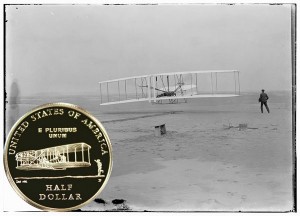Today, the First Flight Commemorative Half Dollar Coin tells the story of the Wright brothers and their efforts 111 years ago.
In the Youngstown Vindicator newspaper on the following day, this article described their success.
=====
Ohio Flyers.
Two Dayton Men Successfully Launch An Airship In South Carolina.
The Machine Flew Three Miles In The Face Of A Wind Going 21 Miles An Hour.
Norfolk, Va., Dec. 18.—A successful trial of a flying machine was made yesterday near Kitty Hawk, NC by Wilbur and Orville Wright of Dayton, OH. The machine flew for three miles in the face of a blowing at the registered velocity of 21 miles an hour and then gracefully descended to earth at the spot selected by the man in the navigator’s car as a suitable land place. The machine has not balloon attachment, but gets its force from propellers worked by a small engine.
Preparatory to its flight the machine was placed upon a platform near Kitty Hawk. This platform was built on a high sand hill and when all was in readiness the fastenings to the machine were released and it started down an incline. The navigator, Wilbur Wright, then started a small engine which worked the propellers. When the end of the incline was reached the machine gradually arose until it obtained an altitude of sixty feet. In the face of the strong wind blowing it maintained an even speed of eight miles an hour.
The idea of the box kite has been adhered to in the basic formation of the flying machine. A huge framework of light timbers 33 feet wide 5 feet deep and 5 feet across the top, forms the machine proper. This is covered with a tough but light canvas. In the center is the navigator’s car and suspended just below the bottom is a small gasoline engine which furnishes the motive power for the propelling and elevating. There are two six-bladed propellers, one arranged just below the center of the frame so gauged as to exert an upward force when in motion, and the other extends horizontally to the rear ofthe center of the car to furnish the forward impetus. Protruding from the center of the car is a huge fan-shaped rudder of canvas stretched upon a frame of wood. This rudder is controlled by the navigator and may be moved to each side, raised or lowered.
=====
The Mount Airy News published a small article on December 23, 1903 about the brothers’ feat.
=====
Flying Machine.
Norfolk, Va., Dec. 18—No test was made today of the flying machine invented by Wilbur and Orville Wright of Dayton, OH, which sailed three miles at Kitty Hawk, NC, Thursday. The Wright Brothers will leave tomorrow for Dayton to spend the holidays and will return to Kitty Hawk after new year’s to perfect their invention.
=====
Both of these articles list their distance as three miles, however the historical account measures their successes differently.
The brothers took turns piloting their flying machine. Orville’s turn was first on December 17, 1903. At 10:35 am, he successfully traveled 120 feet in 12 seconds.
They few three more times that day with each flight growing in length as they gained experience with the flying machine’s “elevator.”
For the fourth flight, Wilbur piloted their flyer a distance of 852 feet in 59 seconds.
The Youngstown Vindicator and the Mount Airy News of the day exaggerated the distance flown but their errors do not detract from the historical significance 111 years later.
The First Flight Commemorative Half Dollar Coin shows against the historical image of Orville’s first flight on December 17, 1903.
